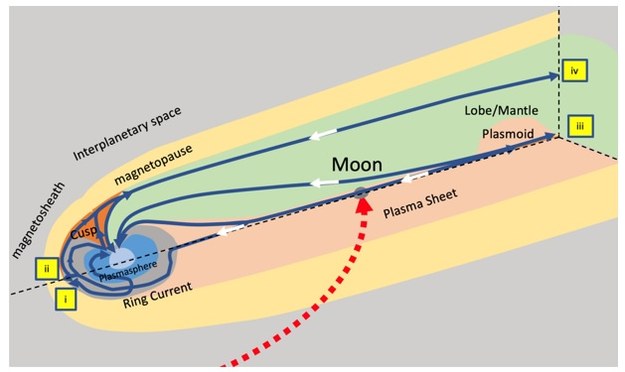Where does water on the Moon come from and where is it stored?
Around Earth, there is a magnetosphere, which is formed by the action of the geomagnetic field. At a greater distance from the Earth's surface, the magnetosphere is curved due to the activities of the solar wind (a stream of charged particles) and the Sun's magnetic field. At the side more distant from the Sun, the magnetosphere creates a magnetic tail containing hydrogen and oxygen ions originating from the Earth. (Similar to the tail of gases and dust particles that we can observe behind comets.) The Moon passes through this magnetic tail regularly during its 29-day cycle and stays inside it always for about five days.
The authors of the study were inspired, among other ideas, by previous observations of the Japanese lunar satellite Kaguya (also known as SELENE), which showed an increased amount of oxygen ions on the Moon when it was present in the Earth's magnetic field. In addition, based on the physical state of these ions, it was clear that they had not originated from the solar wind, but directly from the Earth's ionosphere. Thus, it could be assumed that the ions lost by the Earth could be deposited somewhere on the Moon.
The researchers obtained a gravity model based on the available gravity data, and used it to detect subsurface density anomalies, i.e., pores where water could be hidden. They also used topographic data and a coordinate network from the measurements of the LRO lunar probe (NASA) and its tool LOLA for modelling.
 Figure 1 A cut-away illustration of the magnetosphere showing how ions move (blue and white arrows) and how the Moon passes through the tail of the magnetosphere (red dotted line).
Figure 1 A cut-away illustration of the magnetosphere showing how ions move (blue and white arrows) and how the Moon passes through the tail of the magnetosphere (red dotted line).
"We used an analogy from the Earth," says Günther Kletetschka. "Whenever we used this novel way of plotting the gravity aspects (descriptors), we found areas on Earth associated with potential water aquifers or even oil deposits. So we thought of applying this method to the Moon, its multiple craters carving its surfaces, and compilation of a new atlas of the Moon."
"Our analysis revealed that water on the Moon likely occurs in pore spaces in the areas around its poles. Since the temperature there reaches around -173 °C, the water is stored there in a solid form, for example in the form of a permafrost (permanently frozen soil). On the other hand, at greater depths below the surface (approximately 100-2,000 meters), water could also exist in a liquid form."
Kletetschka's team consists of two students from the Faculty of Science, Charles University, Nick Hasson and Kurosh Karimi. The co-authors of the paper Jaroslav Klokočník and Aleš Bezděk are astronomers from the Astronomical Institute of the CAS and Jan Kostelecký is a geodesist from the Faculty of Mining and Geology at the Mining University in Ostrava.
The team estimates that because the Earth has been losing its ions with varying intensity for about 3.5 billion years, the amount of water thus accumulated on the Moon can be up to about 3,000 km3. This corresponds almost to the area of Lake Vostok in the region around the Earth’s South Pole, which is 5400 km3 large.
And how did the ice filled pores space themselves form? Research suggests that asteroids that hit the Moon's surface create craters. At the same time, a network of pores and fractures is produced parallely to their perimeter by the action of the energy associated with the impact and the pressure of the resulting explosion (expansion of gas).
The results of the study are important for several practical reasons. On the one hand, they show how we can detect water and other fluids on other astronomical objects with the usage of satellites and gravity measurements. And on the other hand, finding areas where water accumulates on the Moon will be crucial in the future, when planning a long-term mission to the Moon (for example, the Artemis mission planned by NASA).
Link to the original paper:
Kletetschka G, Klokočník J, Hasson N, Kostelecký J, Bezděk A, Karimi K. Distribution of water phase near the poles of the Moon from gravity aspects. Sci Rep. 2022 Mar 16;12(1):4501. doi: 10.1038/s41598-022-08305-x. PMID: 35296705; PMCID: PMC8927600.
Document Actions